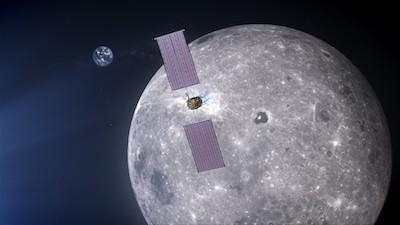Module Expected To Launch On The Second Artemis Mission
The first science experiments that will be hosted on the Gateway, the international research outpost orbiting the Moon, have been selected by ESA and NASA. Europe’s contribution will monitor radiation to gain a complete understanding of cosmic and solar rays in unexplored areas as the orbital outpost is assembled around the Moon.

The first module for the Gateway, the Power and Propulsion Element, is set to launch on the second Artemis mission and will host two external scientific investigations.
ESA’s hardware will actively monitor radiation at all times and return data for all scientists from participating countries to consult.
As the Gateway module flies to its position in a halo-like orbit around the Moon, it will pass through the Van Allen radiation belt – an area around Earth where high-energy particles are trapped by our planet’s magnetic field. The particles can cause more radiation damage to humans, and the hardware will provide useful information on to how to keep astronauts safe as they pass through the belt.
Once in position, the Gateway will orbit the Moon flying as close as 1,865 miles from the lunar surface and at its furthest, 43,500 miles. The radiation investigation will continue to monitor the changes in protons, electrons and heavy ions and neutrons as they hit the measuring instruments.
“Heavy neutrons are of particular interest for us,” says ESA’s Science Team Leader of Human and Robotic Exploration Jennifer Ngo-Anh “some cosmic rays hit the Moon and interact with the surface to reflect as heavy neutrons that are particularly damaging to humans. We need to know more about where and how these particles form, to protect astronauts.”
NASA’s first investigation to fly aboard the Gateway is a Sun-oriented space weather experiment to observe solar particles and solar wind. These phenomena are unpredictable and can cause violent outbursts of radiation that could hit astronauts as they venture farther from the protective atmosphere of Earth.
“Both these experiments will work together to supply much-needed information to forecast radiation events and how to build better spacecraft and protection for astronauts on and around the Moon,” explains ESA’s director of Human and Robotic Exploration David Parker.
“As we prepare for the next generation of European astronauts who will join their NASA colleagues in the Artemis programme, this research is of vital importance and shows how science and exploration go hand-in-hand as we move forward to the Moon.”
More science will be selected to fly aboard the Gateway in the future to take advantage of the unique environment in lunar orbit that cannot be duplicated on Earth or on the International Space Station.
The Gateway will be built and assembled this decade as a platform for science in deep space and as an outpost for astronauts traveling onwards to the lunar surface. It is led by NASA. Following decisions at Space19+, ESA will build a Habitation module, communications systems and a refuelling module for the Gateway. The Canadian Space Agency has committed to provide advanced robotics for the lunar outpost. The Japanese Aerospace Exploration Agency is also in discussion to supply elements.
(Image provided with ESA news release)
 Aero-News: Quote of the Day (11.17.25)
Aero-News: Quote of the Day (11.17.25) ANN's Daily Aero-Term (11.17.25): NonDirectional Beacon
ANN's Daily Aero-Term (11.17.25): NonDirectional Beacon NTSB Final Report: Fred L Wellman CH 750 Cruzer
NTSB Final Report: Fred L Wellman CH 750 Cruzer ANN's Daily Aero-Linx (11.17.25)
ANN's Daily Aero-Linx (11.17.25) Airborne-NextGen 11.11.25: Archer Buys Hawthorne, Joby Conforms, Stranded Astros
Airborne-NextGen 11.11.25: Archer Buys Hawthorne, Joby Conforms, Stranded Astros



